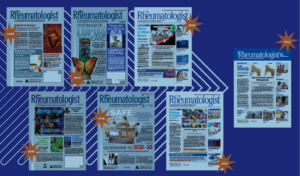 If you’ve been a long-time reader of The Rheumatologist, you may have noticed that things look just a little different in this issue. The logo has changed, the font appears distinct, and the bylines are, for lack of a better term, aligned differently. If you’re looking at this online, the menus have changed somewhat, and the background looks less like it was made in the 1990s. All of this resulted from the work of a large, interdisciplinary team over the course of a year. As a member of that team, I’ve been privileged to see how things are designed, often with a fine-toothed comb and a critical eye toward enhancing the reader experience.
If you’ve been a long-time reader of The Rheumatologist, you may have noticed that things look just a little different in this issue. The logo has changed, the font appears distinct, and the bylines are, for lack of a better term, aligned differently. If you’re looking at this online, the menus have changed somewhat, and the background looks less like it was made in the 1990s. All of this resulted from the work of a large, interdisciplinary team over the course of a year. As a member of that team, I’ve been privileged to see how things are designed, often with a fine-toothed comb and a critical eye toward enhancing the reader experience.
Throughout this process, I’ve been impressed by the thought that the world around is a product of what we design it to be. It’s not only fonts and figures that are crafted—often meticulously—but the entire scope of our civilization. Even as I drive around my home of Iowa City, I see products of design, such as the tiny details on roadside signs and elegant curves on the guardrails. As I open my laptop, I see the personable “We’re working on updates” screen, followed by a desktop full of eye-catching icons. And, in my own clinic, I’m suddenly observing the patterns on the carpet that gently steer people to their rooms and the lighting schema that seems to make things look calmer.
All of these things have made me dive deep into the art and science of design, and prompted me to explore an entirely underutilized paradigm of clinical science: the design-thinking process. How can these insights be specifically applied to the world of rheumatology? Let’s rheuminate.
A Quick Primer
Design thinking seems to have started in the 1940s, based on the nascent science of organizational behavior and psychology.1 In particular, psychologists started to focus on creativity and how creativity can be fostered to solve real-world problems.
Hybridizing with many other fields, such as architecture, engineering, computer science, marketing, anthropology and philosophy, design thinking began to seep in the world of business management. It became “a method of creative action.”2 Design thinkers pioneered and elaborated on several concepts that seem embedded into our everyday world today—things like ergonomics, wicked problems and brainstorming. It also introduced irksome jargon, terms that have lost much of their original meanings, such as think outside the box, touch base, paradigm shift and synergy.3

